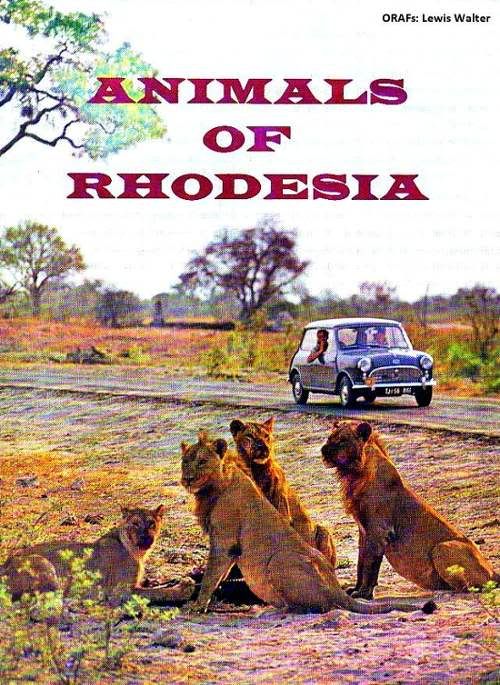
By R. H. N. SMITHERS, O.B.E, B Sc., F.Z.S.
Director of the National Museums of Rhodesia
and member of the National Parks Advisory Board.
RHODESIA can rightly claim to be among the leaders in the field of wild life conservation in Africa, and in spite of the extensive human development which has taken place in the country in the last 20 years, reasonably wide, adequate provision has been made for national parks and game reserves, so that its rich fauna has been secured for future generations.
These areas are well placed in relation to the main tourist routes. In the west, on the line of rail and road between Bulawayo and the Victoria Falls, is the Wankie National Park, which also has an airfield at Main Camp. Both Central African Airways and Rhodesia Railways run scheduled services and package tours all the year round to serve this 5,432-square-mile park, in which some 40 species of wild life over the size of a jackal may be seen, including the recently re-introduced black rhinoceros.
Adjacent to the Victoria Falls, and fringed by the beautiful riverine scenery of the Zambezi River, is a national park of 230 square miles, which is justly famous for its herds of Rhodesia's national animal, the princely sable antelope, apart from many other big game species.
Over 250 miles downstream from Victoria Falls, below Kariba Dam and north of Salisbury, is a game area of over 3,000 square miles. Within this area, east of Chirundu, is the 475-square-mile Mana Pools Game Reserve. Besides the great numbers of elephant, buffalo, impala and other species which can be seen, the grandeur of the Zambezi Valley and the beautiful scenery of the river more than repay a visit.
Game parks have been established near some of the major towns. Close to Bulawayo, the Rhodes Matopos National Park contains a game park full of interest. Its beautiful granite kopje scenery is unique, and it is one of the best areas for seeing klipspringer. Both black and square-lipped (white) rhinoceros have been re-introduced.
To the south-east, near Fort Victoria, the Kyle Game Reserve, alongside Lake Kyle, has been stocked with a range of species such as oribi, Lichtenstein's hartebeest, impala, giraffe and square-lipped rhinoceros.
For the visitor to Salisbury with only a short time to spare, the Robert Mcllwaine National Park lies some 22 miles west of the city. This park contains wildebeest, giraffe, eland and many other species.
There are five other large reserves but these are less accessible.
Outside these reserved areas, and especially in the lowveld, heavy wild life concentrations are still present. Among these the following species are relatively common, although in some instances confined to particular habitats: the elephant, zebra, hippopotamus, giraffe, 22 species of bovids, a family composed of 21 species of antelope and the buffalo, and two species of pig (the warthog and the bushpig).
Even in intensely farmed areas, the kudu, duiker, steenbuck, oribi and reedbuck still hold their own, the kudu in particular being remarkable in persisting in the face of intense human development and hunting. In ranching areas, the wild dog is a pest, and in areas adjacent to broken country the leopard can be a severe menace to livestock.
In agricultural areas, the bush pig has found agricultural development an improvement to its habitat, and it is undoubtedly more numerous than formerly, and a pest in such areas.
Many of the smaller species of wild life are afforded special protection. Among these may be mentioned the aardwolf, which lives almost entirely on termites, and the pangolin, or scaly anteater, which lives on true ants. On the other hand, the black-backed or side-striped jackal, the wild dog, and the spotted hyena are classed as vermin, owing to their depredation on domestic stock.
Such species as the wild cat, the progenitor of all European domestic strains; the genets, with their long, ringed tails, short legs and black or rusty spots; certain of the mongoose, in particular the slender, and white-tailed, persist in built-up areas and are common even in the suburban areas of our larger cities.
With the possible exception of the brown hyena, none of the species occurring in Rhodesia is in danger of extinction for, although some of these, e.g., the nyala, only occur in limited areas within the territory, they are common and wide- spread in adjacent territories.
It is possible that yet other species will in time be added to the Rhodesian list, now consisting of 168 species. It may be shown that species such as the mountain reedbuck, and red duiker, may occur in odd corners, and undoubtedly several species of bats, now known to occur in nearby territories, will be found within our limits.
Photographs by Big Game Photography (Pvt.) Ltd. (11), R. A. B our I ay (5), D. K. Brain, H. Cantle (3), R. Creeth (8), R. Fitt, M. Kerr, W. T. Miller (5), D. Shacklock, Mrs. R. H. N. Smithers (11), M. Trangmar, J. Wightman (5) and I. Young (3).

HEDGEHOG: Clothed in short sharp spines rarely exceeds 8 in; face black forehead white; 2-4 young just before rains; principally insectivorous but also eats worms, slugs, and the young of ground nesting birds; mainly nocturnal; eaten by some African tribes; widely distributed but not plentiful anywhere.
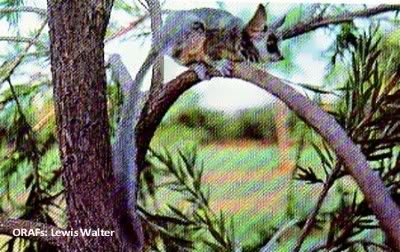 /
/'NIGHT-APE: Overall about 15 in. including a tail about 9 in.; very similar m appearance and habits to the Bush Baby but much smaller; appears lo be more agile, making prodigious leaps from branch to branch of thorn trees in accacia savannas where It is principally found; fairly wide distribution.
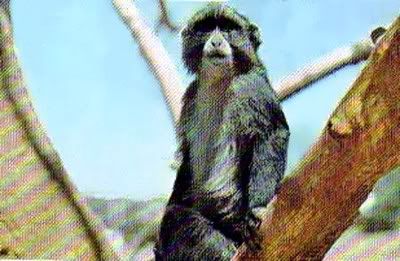 /'
/'SAMANGO OR BLUE MONKEY: 4 ft. overall,, including 2½ ft. of tail dark blue-grey above, flicked with yellow; face brown, legs black, whitish on upper lips and throat; single young, normally early rains; cry, a single abrupt cough; only in the Eastern Districts; forest dweller, small troops; lives on leaves, wild fruit and insects, darker then the Vervet.

BUSH BABY: Overalll about 2½ft. including a tail about 15 in.; grey with bushy tail, large round ears, and lustrous eyes; nocturnal; live. in trees on insects, fruit and bird' eggs, known to kill and eat poultry; cry, o squall and sometimes a chuckle; single young- occur, predominantly in high rainfall areas.
"
BUSH BABY: Overalll about 2½ft. including a tail about 15 in.; grey with bushy tail, large round ears, and lustrous eyes; nocturnal; live. in trees on insects, fruit and bird' eggs, known to kill and eat poultry; cry, o squall and sometimes a chuckle; single young- occur, predominantly in high rainfall areas.
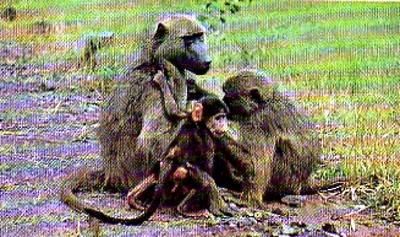
CHACMA BABOON: Males up to 90 lb., females 45 lb.; single young born any time during the year mainly vegetarian but also eats insects and small birds; normally in troops of up to 100; dangerous when cornered; walks. on all fours with tail held high; widespread In Rhodesia; call, a single coughing bark.
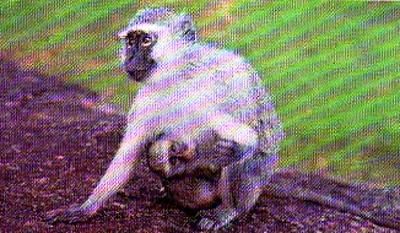
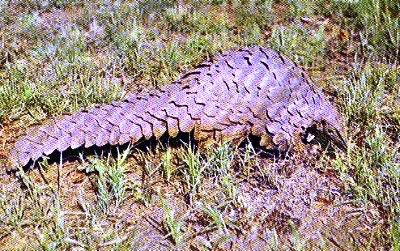
PANGOLIN OR SCALY ANT-EATER: Length up to 3½ ft., nose to tail; light brown overlapping scales; walks on hind feet, using front feet occasionally; curls into a ball when attacked, exuding unpleasant smell; 1 young; found all over Rhodesia, but not common; lives on ants and termites, caught by inserting its 12-in. long tongue into the nest.
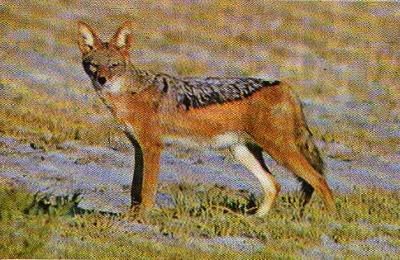
BLACK-BACKED JACKAL: 4 ft. overall, including 15 in. of tail; black and white flecked back like a saddle with demarcation from yellow-red sides and legs; 3 to 6 young; usually in pairs; mainly nocturnal; call, a howl followed by barks; excited jackals chorus a chilling wail; scavengers, also eating small animals, birds and occasionally young of larger game; occurs all over Rhodesia.
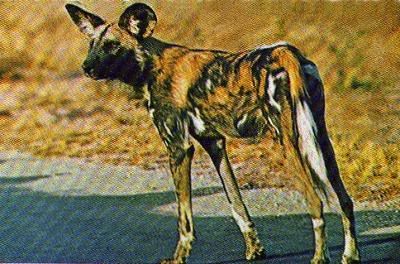
WILD DOG: About 2 ft. 6 in. high, 5 ft. overall, with a 15 in. tail; body blotched with dark brown, yellow and black, large round ears; hunts in large packs; ruthless hunters following quarry biting chunks out of it until it drops from exhaustion; cry, a whinnying sound; about 6 to 8 young; common in remoter areas of Rhodesia.
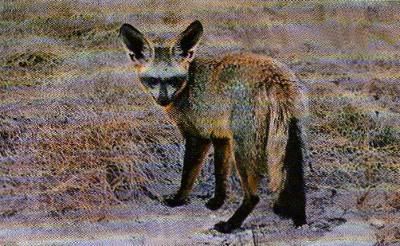
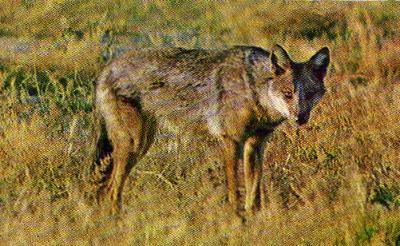
SIDE-STRIPED JACKAL: 4 ft. overall, including 15 in. of tail; grey-brown overall, tail normally with a white tip; 4 to 6 young; nocturnal, rarely seen during day; cry, a series of whoops with yelps, no howl like the Black-backed Jackal; scavenger, but also eats small creatures, birds' eggs and wild fruit; common throughout Rhodesia.
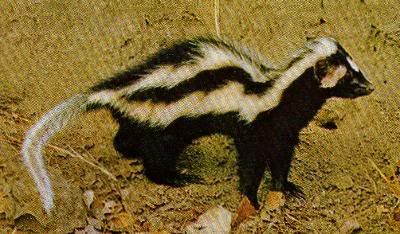
STRIPED POLECAT OR ZORILLA: Length about 27 in., including about 12 in. of tail; coarse black coat with white stripes along the back, tail fairly bushy, black flecked with white, white patches under ears and centre of face; 2 to 3 young; nocturnal; walks with hunched back; eats snakes, small rodents, birds, frogs and insects; widely distributed.
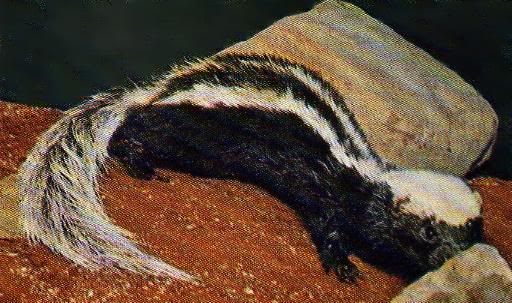
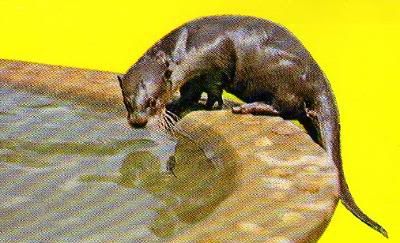
CLAWLESS OTTER: Overall up to 4 ft. 6 in., including about 1 ft. 6 in. of tail, dark brown above, cheeks, chin and throat white, broad head, tail thick; 2 or 4 young; eats crabs, frogs, fish and also rats, small mammals and birds; hind feet only webbed; sometimes seen in family groups, very playful; fairly common.
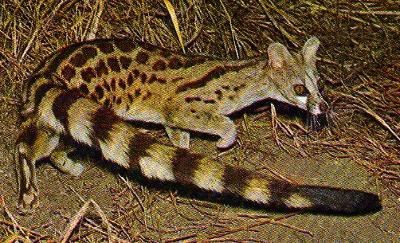
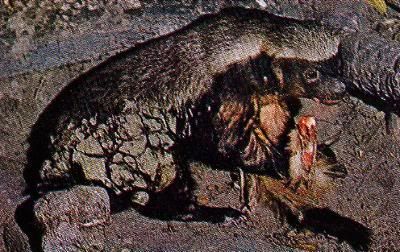
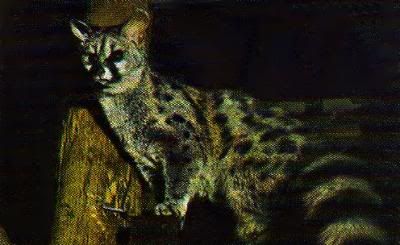
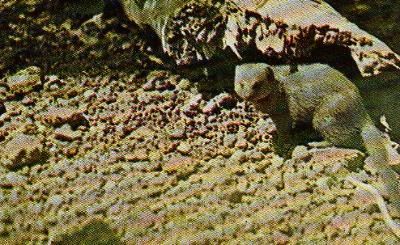
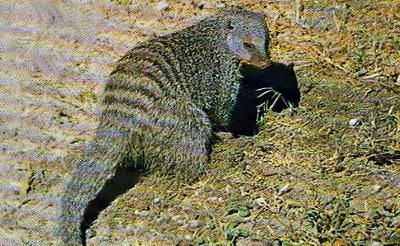

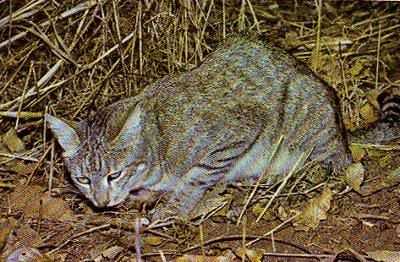

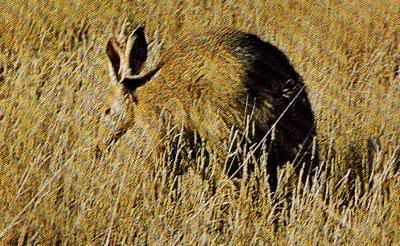
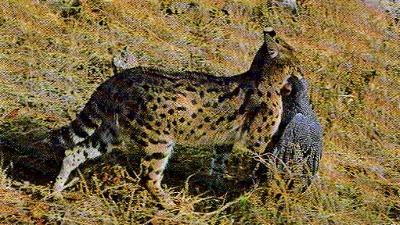
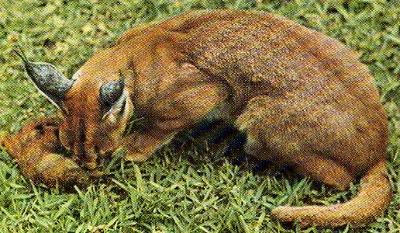
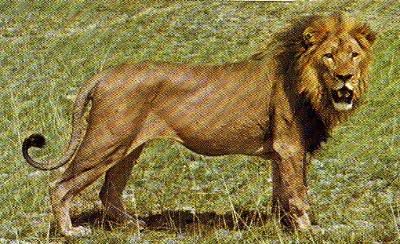
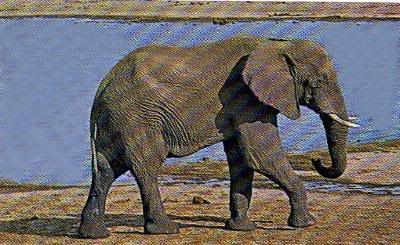
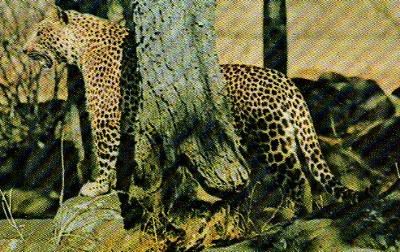

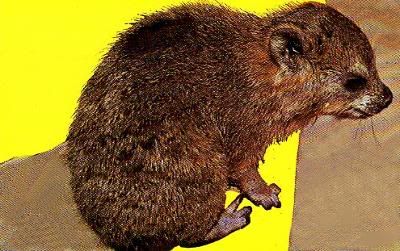

VERVET MONKEY About 4½ ft. overall including 2½ of tail greyish yellow, black-faced, forehead white; single young born any throughout the year; call a chattering cough varied with whistling and grunts; common in wooded areas throughout Rhodesia; feeds on leaves, wild fruit, insects and birds eggs, also raids crops.

PANGOLIN OR SCALY ANT-EATER: Length up to 3½ ft., nose to tail; light brown overlapping scales; walks on hind feet, using front feet occasionally; curls into a ball when attacked, exuding unpleasant smell; 1 young; found all over Rhodesia, but not common; lives on ants and termites, caught by inserting its 12-in. long tongue into the nest.

BLACK-BACKED JACKAL: 4 ft. overall, including 15 in. of tail; black and white flecked back like a saddle with demarcation from yellow-red sides and legs; 3 to 6 young; usually in pairs; mainly nocturnal; call, a howl followed by barks; excited jackals chorus a chilling wail; scavengers, also eating small animals, birds and occasionally young of larger game; occurs all over Rhodesia.

WILD DOG: About 2 ft. 6 in. high, 5 ft. overall, with a 15 in. tail; body blotched with dark brown, yellow and black, large round ears; hunts in large packs; ruthless hunters following quarry biting chunks out of it until it drops from exhaustion; cry, a whinnying sound; about 6 to 8 young; common in remoter areas of Rhodesia.

BAT-EARED FOX: About 12 in. high, 2 ft. 6 in. overall; grey-buff, black legs, forehead white, muzzle black, conspicuously large ears; 3 to 5 cubs; nimble animal, sidestepping and doubling-back on its tracks; feeds on insects, scorpions and spiders, also wild fruit; occurs in Wankie National Park and the south-west of Rhodesia.

SIDE-STRIPED JACKAL: 4 ft. overall, including 15 in. of tail; grey-brown overall, tail normally with a white tip; 4 to 6 young; nocturnal, rarely seen during day; cry, a series of whoops with yelps, no howl like the Black-backed Jackal; scavenger, but also eats small creatures, birds' eggs and wild fruit; common throughout Rhodesia.

STRIPED POLECAT OR ZORILLA: Length about 27 in., including about 12 in. of tail; coarse black coat with white stripes along the back, tail fairly bushy, black flecked with white, white patches under ears and centre of face; 2 to 3 young; nocturnal; walks with hunched back; eats snakes, small rodents, birds, frogs and insects; widely distributed.

STRIPED WEASEL OR SNAKE POLECAT: Similar colour to Polecat, but smaller; overall 20 in., tail 8 in,; hair short, coat black with white top to head, black stripes along back, white tail; emits strong-smelling liquid when alarmed; 2-3 young; hunts by night; eats small rodents, birds and insects; uncommon, only recorded rarely in Mashonaland and Eastern Districts.

CLAWLESS OTTER: Overall up to 4 ft. 6 in., including about 1 ft. 6 in. of tail, dark brown above, cheeks, chin and throat white, broad head, tail thick; 2 or 4 young; eats crabs, frogs, fish and also rats, small mammals and birds; hind feet only webbed; sometimes seen in family groups, very playful; fairly common.

GENET: Two species occur—the Rusty-spotted and the Small spotted, both overall about 3 ft., with 18 in. tails. Both long-bodied, short-legged creatures with long black-and-white ringed tails, sharp features and large ears; nocturnal; lives on rodents, birds, insects and poultry; 2 or 3 young; common. (Rusty-spotted shown.)

HONEY BADGER OR RATEL: Overall up to 3 ft.; black with a long grey or whitish saddle on the back, short bushy tail; 2-3 young; cats small animals, birds' eggs, insects, wild fruit and bee larvae, being immune to bee stings which do not penetrate its exceptionally thick, tough skin; nocturnal, but occasionally seen by day; fairly common.

GENET: The Small-spotted, the second of the two species which occur in Rhodesia. Similar in habits to the Rusty-spotted, it is found in the same areas. The spotting of the body and banding on the tail is black and it has a crest of long black hair down the back.

DWARF MONGOOSE: Overall about 14 in. including 5 in. of tail; smallest of 9 species of Mongoose in Rhodesia; varying from brown to grey; 2 to 4 young; eats insects, berries, birds' eggs and small reptiles; cry is a low chattering mixed with whistling; commonest in lowveld areas.

BANDED MONGOOSE: Overall length about 2 ft.. Including 10 in. of tail; brown-grey, with dark stripes on lower back, dark coarse haired tail; run in troops of up to 50, larger than those of the Dwarf Mongoose; 1 or 2 young; widely distributed in lowveld areas.

SPOTTED HYENA: Size of large dog; sloping back; red-brown to dirty grey, large black spots on body, large round ears, slight mane on back; cowardly but dangerous; lives on carrion, the sick, wounded and new-born; nocturnal; cry, an undulating howl, when excited the characteristic chilling "laughter"; up to 4 young.

WILDCAT: Similar size to domestic cat but with longer legs; buff grey above and pale ochre on the underside, reddish at the back of the cars, black leg-markings more pronounced than domestic cats; nocturnal; eats 'rodents, birds and snakes; up to 4 young; very fierce for its size; common.

AARDWOLF: Shoulder height about 19 in., overall about 3 ft., including 10 in. tail; cream to buffy with black vertical stripes on body and horizontal stripes on legs, bushy tail with black end; the heavy mane along its back can be erected; 2 or 3 young; nocturnal; feeds almost exclusively on termites. Widely distributed, but nowhere common.

ANTBEAR: Overall about 5 ft., including about 2 ft. of tail; heavily built, long ears and snout, powerful tail; greyish with sparse hair; 1 young; nocturnal; lives on ants and termites by digging open an anthill and catching the ants on its sticky 18-in. long tongue; clumsy gait, distribution general throughout Rhodesia.

SERVAL: About 24 in. high at shoulder and 3 ft. 6 in. overall; yellow with black spots coalescing into lines on the shoulders and back, long legs, small face, large ears, short tail; preys on birds, rodents and smaller buck; prefers fairly dense cover; 2 or 3 young; fairly common central and eastern Rhodesia.

CARACAL: Shoulder height about 18 in., length up to 4 ft.; body reddish with white chin, throat and upper lip, dark spots on underside, long pointed ears black at back, long hairs forming tassels at the tips; preys on small game, rodents and birds; 3 young; seen by day, but hunts mostly by night; fairly widely distributed, but uncommon.

LION: Height about 3 ft. 6 in., overall up to 10 ft.; tawny body colour, whitish underparts; male normally has a large mane, usually dark brown, occasionally black; female, slightly smaller, no mane; preys on antelope, buffalo, and if hungry, smaller game; gregarious by nature, lions hunt in prides; 2 to 4 cubs; present in most game areas.

AFRICAN ELEPHANT: Bull, shoulder height up to 11 ft.; weight 6 tons, pair of tusks average 50-100 lb., 180 lb. known in Rhodesia; female smaller; feeds mainly on leaves, grass, wild fruits, roots and bark; assemble in large and small herds; gestation period 18 months female calf, 22 months male calf; common in larger game reserves; unmolested, fairly placid but should be treated with respect.

LEOPARD: Height about 24 in., length about ft.; rich yellow closely-marked with groups of black spots forming rosettes, long tail curling at dark tip; more powerful, with larger head, than cheetah; nocturnal; preys on medium and small-size antelope, monkeys and baboons; rarely seen because of its skill in concealment and silence; fairly widespread in the less settled areas.

CHEETAH: Shoulder height 2½ft., overall about 7 ft.; yellow-fawn with black spots, long tail ringed at tip; carries head low and back hollow; smaller head and longer legs than the leopard; hunts medium arid small antelope by running them down; credited as fastest animal over short distances; 2 or 3 cubs; fairly common in game areas.

ROCK DASSIE: Overall about 22 In.; in build like a large guinea pig; dark brown with distinct black spot middle of the back; feet padded and soft enabling it to move on rocks and trees with great agility; vegetarian, eats shoots, leaves and wild fruits; occurs in colonies in rocky formations often alongside the Yellow-spotted Dassie which is less common; widely distributed.
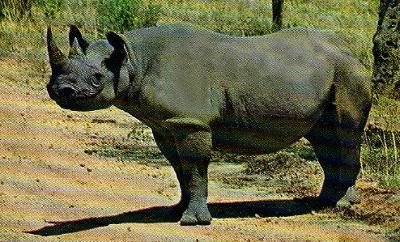
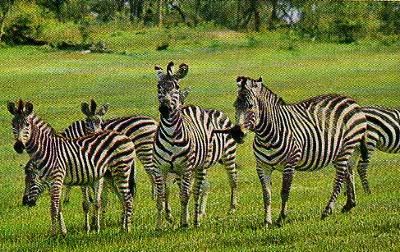
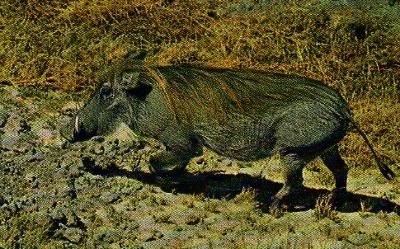
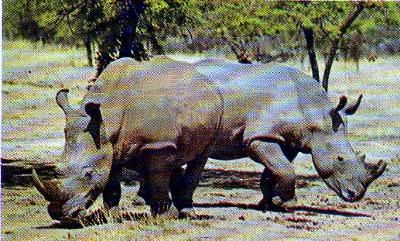
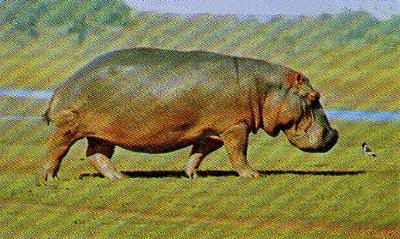
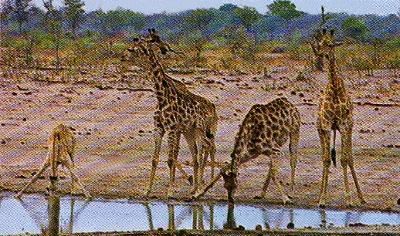



BLUE DUIKER: Shoulder height about 12 in.; dark fawn brown; second smallest antelope after the Suni; found in dense forests; feeds on leaves, shoots, etc.; single young; moves in an erratic, zigzag way, showing the white underside of its tail as it wags; found only in the Eastern Districts.
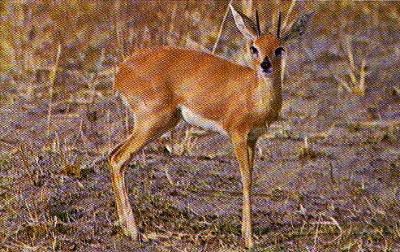


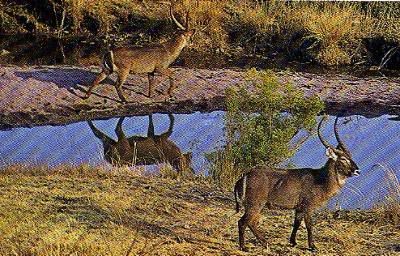
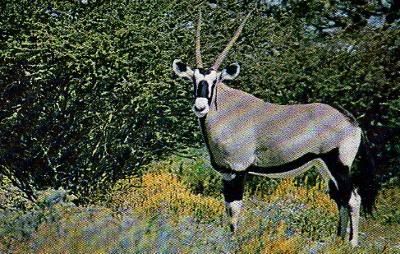
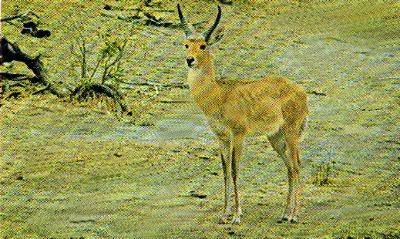
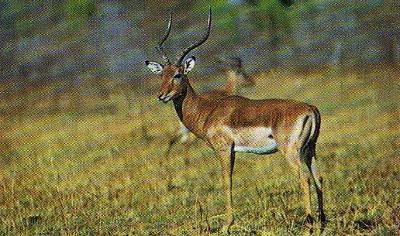
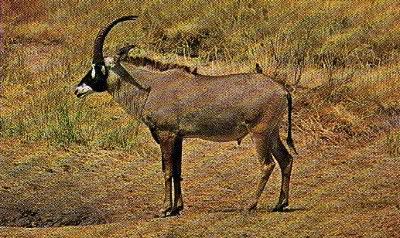
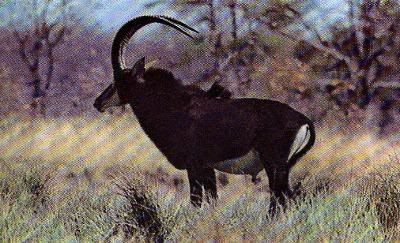
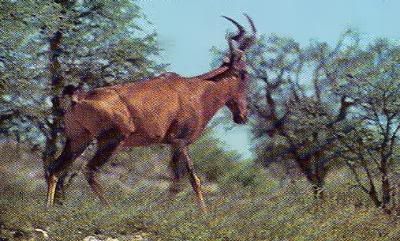
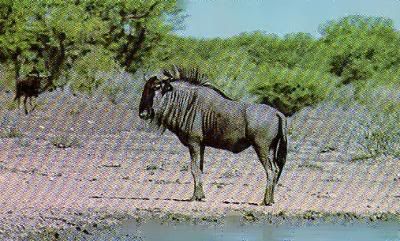
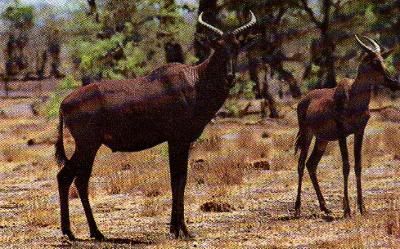
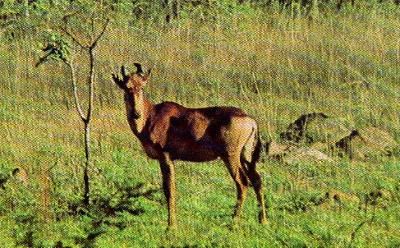
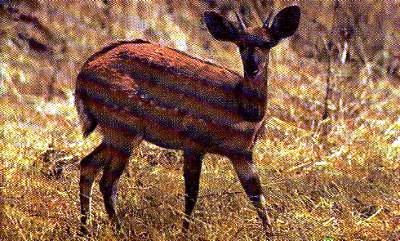
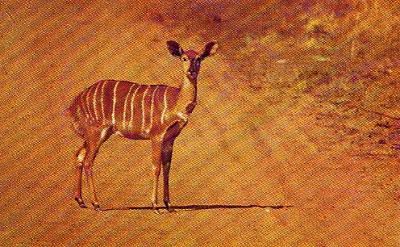
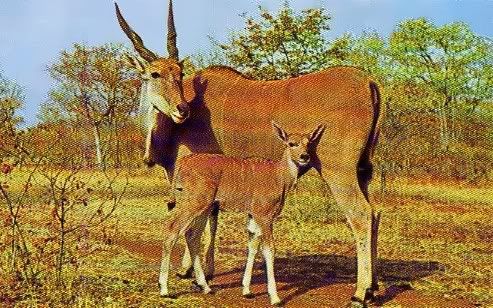
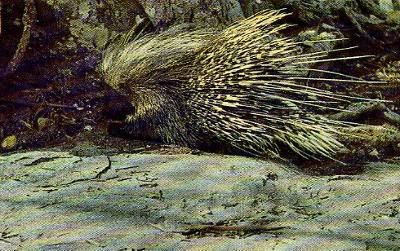
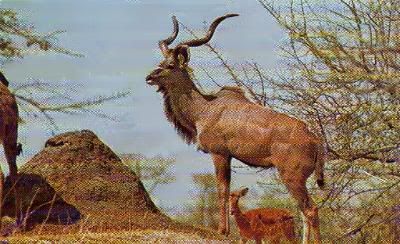
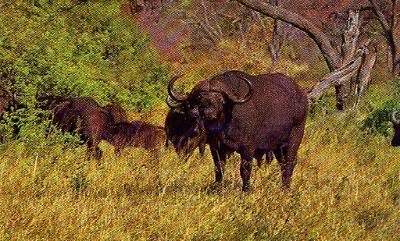
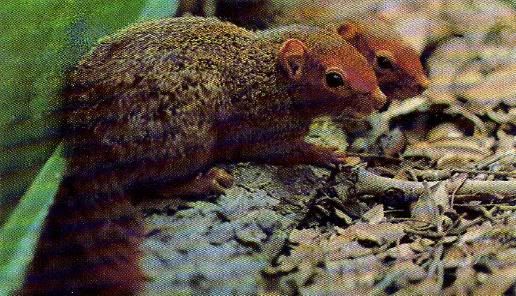
End of Article

BLACK RHINOCEROS: Shoulder height 5 ft. male, 4½ ft. female; weight about 1¼ tons; browser, upper lip pointed, overlapping lower enabling it to grasp twigs and leaves; feeds at night, early morning and late afternoon; occurring naturally in the Zambezi Valley, two small areas in the north-east and the Chipinga district. Reintroduced to Wankie and Rhodes Matopos National Parks.

ZEBRA: Height about 4 ft., weight up to 900 lb.; female usually heavier and bulkier than the male; gregarious, collecting in small herds and associating freely with wildebeeste, tsessebe and other antelope; grazers, moving great distances during dry season to reach water; nervous animals; fairly plentiful in most game areas.

WARTHOG: Shoulder height about 30 in., overall 5½ft., including 20 in. tail; nearly hairless, some bristly hairs on back of neck and shoulders; two large knobs on each side of muzzle; large curved tusks, diurnal: feeds on grasses, roots and wild fruits; holds tail stiffly erect when running; up to 8 young; dangerous when cornered; wide distribution.

WHITE OR SQUARE-LIPPED RHINOCEROS: Shoulder height 5½ ft. male, 5 ft. female; weight about 2 tons; grazer, broad, square upper lip enabling it to crop grass; eyesight of both rhinos bad but senses of smell and hearing good; mild-tempered compared with Black Rhino; reintroduced to Kyle Game Reserve and Rhodes Matopos National Park.
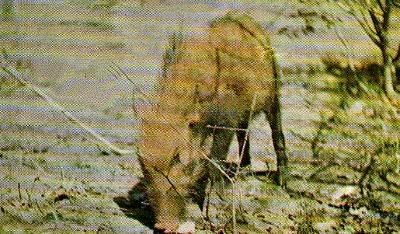

BUSH PIG: Slightly larger than warthog; red-brown to grey-brown body covered in coarse bristles, white and black hairs in crest on back; short tusks; tail hangs down when moving; feeds at night on grass, roots, wild fruits, occasionally carrion; destructive to all cultivated crops; can be dangerous; wide distribution.

HIPPOPOTAMUS: Height up to 4 ft. 6 in., weight about 2 tons; aquatic, most of its time semi-submerged; 4 large curved teeth, one in each front corner of mouth are formidable weapons; grazers; single young born after gestation period of 7-8 months; assemble in schools; dangerous if molested, or when with young.

GIRAFFE: Height 16 ft., weight 1½ tons; browses off foliage of lofty acacia and other trees; small herds; able to go without water for long periods; normally gentle, they can deliver a most powerful kick with fore or hind legs when attacked; confined to western and southern areas.

COMMON DUIKER: Shoulder height 2 ft., weight about 40 lb., females normally slightly larger; grey-brown with black marks on centre of face; straight, slightly diverging horns males only; eats leaves, wild fruit, roots and gross; wide variety of habitats; solitary, rarely seen in more than pairs; tails constantly wag while walking; wide distribution.

SHARPE'S GRYSBOK: Shoulder height 18 in., weight about 20 lb.; small straight horns, males only; red-brown rough coat flecked with white, pale underside; browser; inhabits thick woodlands especially in broken country; seen singly or in pairs; widely distributed north and south of the plateau.

BLUE DUIKER: Shoulder height about 12 in.; dark fawn brown; second smallest antelope after the Suni; found in dense forests; feeds on leaves, shoots, etc.; single young; moves in an erratic, zigzag way, showing the white underside of its tail as it wags; found only in the Eastern Districts.

STEENBOK: Shoulder height about 20 in., weight about 30 lb., females slightly larger; large ears with small straight wide-set horns, red-fawn, white on underside, very small tail; grazes on open veld; seen singly or in pairs; when in flight runs a zigzag course; wide distribution.

ORIBI: Shoulder height 2 ft., weight about 30-40 lb.; tawny-red with pale underside, distinctive black tail, narrow, pointed ears, small straight horns in male; groups of up to six; grazer; occurs in Mashonaland and south-eastern lowveld and west of this only on Gazuma Pan, north of the Wankie National Park; introduced to= Kyle Game Reserve.

KLIPSPRINGER: Shoulder height about 2 ft., weight about 36 lb.; grey-brown coarse spiny coat, flecked with yellow; small straight horns, male only; appears to stand on tip-toe; inhabits rocky hills and kopjes, an agile jumper on rocks; predominantly a browser; single young; fairly widespread, but extremely shy.

WATERBUCK: Shoulder height about 4 ft., weight up to 400 lb.; long coarse dark-brown coat, white markings on tail, distinctive ring on buttocks, horns, male only, long curving outwards, back and forwards; powerful but very shy; grazers; found near water, to which they take freely if alarmed; small herds in the lowveld.

GEMSBOK: Shoulder height about 4 ft., weight 450 lb.; grey body, black on upper legs joined by black along lower side, white rump, black and white face markings, long black tail; horns long, straight, both sexes; small herds: prefer drier regions; grazer and browser; found only in the Wankie National Park.

REEDBUCK: Shoulder height about 3 ft., weight about 140 lb.; drab yellow wiry coat, 15-in. horns curve out widely with tips facing forward, male only; when running white underside of the tail "flashes"; small groups in open vleis and riverine areas; widely distributed and quite common within a few miles of Salisbury.

IMPALA: Shoulder height about 3 ft., weight, male 130 lb., female 100 lb.; reddish-fawn coat, white undersides and inner rump, vertical dark stripes on outer rump; lyre-shaped horns, males only; browsers and grazers preferring woodland cover; herds of 100 (200 not unknown); when alarmed they bound away, jumping high over bushes; fairly widespread.

ROAN ANTELOPE: Shoulder height about 4 ft. 6 in., weight up to 550 lb.; brown-grey, black and white face, long tail, dark mane, long ears stick out at side with hair on ends forming tassels; horns, both sexes, sweep back in single curve; small troops; lighter colour than Sable, smaller horns and longer legs; fairly widespread north and south of the plateau.

SABLE: Shoulder height about 4½ ft., weight up to 500 lb.; males black, females dark-brown; young, reddish-brown with white underparts and inner rump, black and white facial markings; large horns sweep back in single curve in both sexes; gregarious; grazer; widespread; national animal of Rhodesia.

RED HARTEBEEST: Shoulder height about 4½ ft., weight 350 lb.; yellowish-brown body, dark legs and tail, dark markings on long faces; high-shouldered; the heavy-ringed horns spread outwards, inwards and then backwards in both sexes; predominantly a grazer; small herds in open bush and plain; only occurs in extreme S.W. corner of Wankie.

BLUE WILDEBEEST: Shoulder height obout 4½ ft., weight 500 lb.; dark silver-grey, black mane, long black tail; long face with ears projecting sidewards; heavy horns curving outwards and downwards, curved up at the ends; large herds, associating with other antelopes; grazer; strange prancing gait, with head down; fairly common.

TSESSEBE: Shoulder height about 4 ft., weight 300 lb.; chocolate brown, with iridescent sheen, appearing purplish in some lights; dark face, paler towards rump; horns short, heavily ringed, spreading widely at base, then back inwards at tip in both sexes; small herds; grazers; great speed and stamina; patchy distribution.

LICHTENSTEIN'S HARTEBEEST: Shoulder height about 4 ft., weight 300 lb.; chestnut upper parts, yellowish-red lower, white patch on rump; horns, both sexes, curve outwards, inwards, back and inward again; small herds on open plains; predominantly a grazer; occurs in S.E. lowveld and a restricted area in N.E.

BUSH BUCK: Shoulder height obout 3 ft., weight about 200 lb.; male, dark brown, white markings on throat, chest and legs, white spots on flanks, large ears white inside; horns long, widespread, spirally curved; female, no horns; light reddish tawny colour; prefers dense woods; predominantly a browser; white underside of tail "flashes" when running. Widely distributed.

NYALA: Shoulder height about 3½ ft., weight 300 1b.; male, brown- grey, conspicuous vertical light stripes on back, mane running along back, long hair underside from throat to rear legs, long lyre-shaped spiralling horns; females (as above) light brown, large ears, no horns or mane; predominantly a browser; confined to S.E. lowveld; small herd in Chewore-Zambezi confluence area.

ELAND: Shoulder height obout 5½ ft., up to 1,200 1b.; yellow-fawn, light lower face and chest, dark nose, humped shoulders; nearly straight horns, spiralled at base, project back and outwards; horns of female lighter than male; pronounced dewlap in male; largest antelope; predominantly a browser; large herds; placid, shy; fairly wide distribution.

PORCUPINE: Length 2½ ft., weight up to 40 1b.; body and tail covered with black and white quills which can be erected when threatened; quills can cause festering wounds; crest of long wiry bristles on top of head; nocturnal; eats bulbs, roots, fruit and raids crops; two young; widely distributed but rarely seen.

KUDU: Shoulder height about 5 ft., males up to 550 lb., females, 350 lb.; male, fawn-grey, vertical light stripes on back, mane along back, long hair throat and chest, white bar across eyes, large horns, pronounced triple-spiral in developed males; females, slightly reddish, no horns, small herds up to 20; browser; common, wide distribution.

BUFFALO: Shoulder height about 5½ft., weight 1,500 lb.; old adult males, black; females and young, lighter brown; heavy-set; massive horns curving down over the head and up at tips; bosses provide head protection; grazers; large herds; normally inoffensive, dangerous if provoked; widely distributed in N. and S. low country.

RED SQUIRREL: Overall about 16 in. including 9 in. of tail; grey brown above; auburn on the face, underparts and tail; eats seeds, berries and wild fruit; confined in distribution to evergreen forests in Eastern Districts; least common of 3 species found in Rhodesia. Sun Squirrel also in Eastern districts; Bush Squirrel common.
End of Article
Extracted and recompiled, by Eddy Norris, from a publication which was made available to ORAFs by Lewis Walter a District Commissioner in Rhodesia. Thank you Lewis.
Original publication was published by the Rhodesia National Tourist Board.
Printed in Rhodesia by Unitas Press, Salisbury.
The recompilation was done for no or intended financial gain but rather to record the memories of Rhodesia.
Original publication was published by the Rhodesia National Tourist Board.
Printed in Rhodesia by Unitas Press, Salisbury.
The recompilation was done for no or intended financial gain but rather to record the memories of Rhodesia.
Thanks to
R.H.N. Smithers and all photographers.
R.H.N. Smithers and all photographers.
Paul Norris for the ISP sponsorship.
Paul Mroz for the image hosting sponsorship.
Robb Ellis for his assistance.
Should you wish to contact Eddy Norris please mail me on orafs11@gmail.com
Thanks for the reprint. It's amazing to see the variety of animals in Rhodesia, since we always think of the most common African animals. I am sure that there are many more to be included.
ReplyDeleteBob Heffner
It's difficult, but it doesn't goal we don't look things that are good for us all time we see for useful mega888 pc download services. The more we use them in any list, the more we can look what is useful allow us choose.
ReplyDeleteFirst, players must be open to all techniques and strategies. Learn a lot of tricks, learn a lot of things 918kiss apss/
ReplyDelete918 casino
918live ios
918kiss apk casino
casino malaysia
and participate in many tournaments. In most cases, playing poker games will hold regular international tournaments. If you are confident in your skills and sufficient training, it can be considered a career!
https://918kissapkiosdrive.car.blog/
http://jcorso.jigsy.com/
https://mattheq.livejournal.com/491.html
https://crutcher.doodlekit.com
https://www.evernote.com/shard/s724/sh/e8cfa898-924d-46a8-a41b-
a2957cfaec42/0c94efcdbac5844ffac4fea0edebdd24
Many people yet bewilderment if the formula of baccarat casino royale word count table tennis robots will help create baccarat easier to discharge duty and earn genuine money, or like these issues arrive to mind in many people. We are looking for an answer to this problem. Use table tennis formulas to take steps baccarat more easily, and if you know how to use baccarat, you can get more money. later playing cards, table tennis will back up you accomplish your goals faster. For example, today you set a object or profit. with the rhythm and opportunity come, you will acquire rid of baccarat. After the ping pong cards arrive out, door your eyes first. once you are distinct that the ping pong cards are OK, place more bets per round and continue playing. back replacing the card. since changing the card, you will create a considerable gain and may even exceed the purpose you set. The forgive baccarat formula can help you pretense baccarat card games.
ReplyDeletenice
ReplyDeleteYou got a really useful blog I have been here isSuu
ReplyDeletereading for about half an hour. I am a newbie and your post is valuable for me. https://issuu.com/agencydgsol